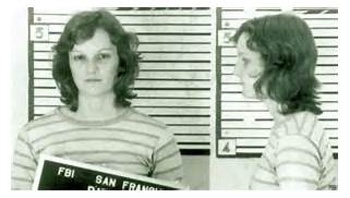
Viewers of CNN will recognize Jeffrey Toobin from his frequent TV appearances as an analyst of court issues. The Harvard-educated lawyer and journalist, who has written two award-winning books on the U.S. Supreme Court, has been most recently recognized as the author of The Run of His Life — The People v. O. J. Simpson, most recently used as the basis for last season’s highly acclaimed and Emmy-nominated miniseries of the same name.
In his latest book, published this month by Doubleday, Toobin takes up the subject of Patty Hearst — the heiress turned radical whose story filled the airways and newspapers of the mid 1970s. As in his earlier works, Toobin shows his skills as a masterful storyteller, wordsmith and researcher, creating a work that is likely to soon be a best seller.
People aged fifty and above will recall the story of Patty Hearst. Those younger will recognize the name, but probably little else. For the benefit of those who remember and those who don’t, here’s a brief synopsis of the story that made headlines some 40 years ago.
Patricia Campbell Hearst became a household word on February 4, 1974 when she was kidnapped from her apartment near the University of California at Berkeley. The granddaughter of William Randolph Hearst — creator of the largest newspaper empire in American history and the supposed model for the central character in everybody’s favorite classic film Citizen Kane — Patty’s kidnapping immediately became the biggest news story of the time.
News accounts revealed that her captors where a radical group known as the Symbionese Liberation Army (SLA), led by Donald DeFreeze, an escaped felon who had at one time in lived in Cleveland and who — for those who don’t recall — happened to be black. In their initial statement, the SLA demanded the release of two of their cohorts who had been arrested for the murder of Oakland, California’s first black school superintendent Marcus Foster.
When this demand was not met, they shifted their focus to a more Robin Hood type demand — $70 ($375 in today’s dollars) worth of food to every needy person in California. In attempts to meet these demands, the Hearst family came up with $2 million (more than $10 million in today’s money) for the Bay Area poor — still less than the captors’ request. Unfortunately, the distribution turned into a debacle and Patty remained in custody. When the first of a series of taped recordings surfaced, the nation and Patty’s parents learned that she was safe.
Two months after her capture, the SLA released a second tape of Patty, announcing that she had joined the movement. When she announced that she was now to be known as “Tania” — a non de guerre inspired by the girlfriend of the revolutionary Che Guevara — suddenly the world wanted to know whether or not Patty was a victim or a radical, which becomes the central issue of Toobin’s book. But Patty’s image as the victim went south when she was photographed on April 15, 1974, wielding a M1 carbine while robbing the Hibernia Bank in San Francisco. Within days U.S. Attorney General William Saxbe labeled Hearst a “common criminal.”
The plot thickened when on May 17, DeFreeze, Hearst’s primary captor and head of — now known as Cinque after the captured African who lead the revolt of the slave ship Amistad — and five associates were killed in a bloody shootout and fire in a Los Angeles neighborhood. But with DeFreeze/Cinque dead, “Tania” remained on the lam — a period that lasted a total of 19 months. She would claim that during the entire period of time she was still under the control of the SLA, a defense that smacked of “the devil made me do it.”
Readers will develop little sympathy for her parents, Randy and Catherine Hearst. They come off as cold and at time more concerned about their own image than that of their daughter. The FBI comes across at times as bumbling but readers should not fall into the trap of imputing 21st century forensic technology to a crime that happened in the mid 1970s. The turf wars between the federal, state and local authorities did not help the overall investigation, but even with these caveats, it seems difficult to understand how the FBI and law enforcement did not do a better job of tracing and analyzing the tapes, following up on leads and utilizing the evidence that was available in order to find a woman that was often times not far out of plain view.

Although the now 62-year-old Hearst declined to be interviewed for the book, Toobin did an amazing amount of research to seek out the real Patty Hearst. Using court transcripts, FBI records and documents, plus the numerous memoirs and biographies that have emerged from major and minor actors that sought their fifteen minutes of fame because of their association with Hearst, he was able to retell the story in amazing detail. He also had available Every Secret Thing, Hearst’s 1982 memoir, along with the numerous interviews and articles that she has written and given over the years, giving him the ability to oftentimes use her own words.
Each reader must draw their own conclusions regarding the truth and veracity of Hearst’s defense and claims of innocence as a kidnap victim turned revolutionary turned all American girl, and Toobin does a good job of laying out the facts in an unbiased and non-judgmental style. Some early reviews on Amazon.com condemn Toobin’s interpretation, accusing him of “blaming — drawing on their belief that Hearst, at all times during her captivity, was under the control of her captors and had no choice but to engage in the bank robberies, the building of pipe bombs and eluding authorities — a position which, in my opinion, is inconsistent with the known facts. But once again, that is open to each reader’s interpretation.
The Hearst that I perceived was in fact a victim of a kidnapping and was subjected to confinement and indoctrination in the early months of the saga. And during those first months she clearly did what she had to in order to stay live. But once DeFreeze and the hardcore of the SLA was dead, she appears to have had ample opportunity to walk away.
While much is made of the sexual power supposedly exerted over Hearst as part of the mind control that created Tania, I found little evidence of non-consensual sexual contact. And for the record, Toobin makes a strong case to demonstrate that it is highly unlikely that Hearst ever had sex with DeFreeze. Granted, there is the legal concept that a person held in custody cannot give consent to a sex act, but the legal question arises after the death of DeFreeze as to whether Hearst was in fact held against her will, particularly when you consider the ample opportunities she had to walk away and the numerous love letters that she wrote to her two white male sexual partners during and after her captivity.
In the 1970s the concept of brainwashing had come into the common parlance as the result of the Korean War. This can be coupled with the fact that millions of Americans had been enthralled with the 1959 best seller, The Manchurian Candidate, or had seen the 1962 movie of the same name. In addition, white America had long been engrained with the subliminal message that once there was integration, black men could easily overpower white women. So here was this flower of white womanhood, made the victim of the indoctrination and sexual violence, allegedly by a black man.
F. Lee Bailey, the lawyer that handled Hearst’s 1974 trial for bank robbery, comes across as anything but the paradigm of an ethical lawyer. But even with his foibles, he and his partner did an admirable job of defending Hearst. She was ultimately convicted of the bank robbery and use of a firearm, incurring a sentence of six years, a sentence which was calculated to be about the average sentence that defendants similarly situated would have received.
Bailey skillfully worked a deal with the prosecution to keep Hearst from being charged with the second bank robbery committed by the SLA, where she drove the getaway car. During the course of that bank robbery, 42-year-old Myra Opsahl, mother of four teenage children, was killed. Anyone who has watched more than an hour of Court TV will quickly realize that with a conviction in connection with a bank robbery where a person is killed, any participant is likely to spend years in jail. Driving the getaway car in a bank robbery in which a person dies is clearly aiding and abetting in a capital murder case. But thanks to the deal Bailey made and Hearst turning state’s evidence against her former comrades in arms, she walked on that charge.
But when Hearst got new lawyers who sought to get a reversal of the conviction, she accused Bailey of incompetency of counsel — a strong claim against one of the best known and most successful criminal lawyers in the nation and a lawyer who had saved her from a being charged with the more serious offense. More egregiously, she completely disassociated herself from Bailey’s co-counsel who had been the workhorse of the case and literally abandoned his own family in order to become a surrogate father to Hearst, devoting almost five years of his life to her case and her personal well-being.

While the now 62-year-old Hearst perceives herself as totally blameless of any criminal activity, it should not be over looked that while a member of the SLA, she highjacked cars, help make improvised explosives devises, one of which failed to detonate in two unsuccessful attempts to kill police, made detailed plans for at least one of the bank robberies, and aided and abetted in numerous other crimes. Nor should the incident of May 1974 be overlooked. On this occasion Hearst fired 27 rounds from her firearm in an attempt to rescue one of her compatriots who was in a scuffle with the police — an incident that occurred after she had been sitting in a car alone, with the vehicle’s keys in the ignition for more than an hour. She could have simply driven off to her freedom.
As Toobin relates the tale of Patty Hearst, he manages to integrate many subplots and coincidental facts and occurrences into the story. Some facts are so intriguing and fascinating that the reader will come away saying “…you can’t make this stuff up.’
By May of 1978, and a year or so of appeals, Patty finally arrived at the jailhouse door. But her family immediately launched a media offensive to insure her release. Like the scion of the family, William Randolph Hearst, who helped start the Spanish-American war and epitomized the term “yellow journalism,” the family launched an all-out assault on the Carter administration to obtain a presidential pardon. That resulted in a commutation of her sentence. On February 1, 1979, after serving 21 months in jail, thanks to a pardon granted by President Jimmy Carter, Patty Hearst was a free woman.
But in the mindset of Patty Hearst, the effect of the pardon was mostly symbolic even though it included a restoration of her rights, such as the ability to purchase and possess firearms. She was not finished with her campaign to restore her image. She wanted to be totally vindicated in the form of executive clemency. In the late 1990s she petitioned President Bill Clinton for something that is rarely granted, still relying on the claim that she had been raped by DeFreeze and others in the group.
In response to this claim, the U.S. attorney from San Francisco pointed out to President Clinton in a memo that the allegations of rape by DeFreeze and others were no more credible now than they had been in the 1970s, a point that Toobin makes several times in the book, quoting fellow members of the SLA and Hearst herself.
But Clinton, bending to political pressures, none stronger than that of President and Mrs. Jimmy Carter, granted the order making Hearst probably the only person in American history to receive both a pardon and an order of clemency.
While the acts of the gun-toting Tania may be erased from the annals of the law and the courts, what Patricia Campbell Hearst did should not be erased from the minds of America. Had she been Patricia Campbell or Patricia “average American,” I would argue that she would have suffered the full consequences of her acts and might still be in jail.
Toobin aptly subtitles his book The Wild Saga of the Kidnapping, Crimes and Trials of Patty Hearst. His choice of the adjective “wild” was wise. Because that is exactly when the story is — wild. The phrasing of the title also raises the subtle message of the book — was Patty Hearst a victim or a participant in criminal activity? The reader becomes the jury.
By the end of the book, I clearly did not like Patty Hearst and had no sympathy for her position. Other readers may not agree. But in my opinion, she came across as a self-centered user who would bend to the wind whenever it fit her fancy. People who helped her and befriended her where quickly discarded when they were no longer of use to her. Once she was free from incarceration, Patty returned to the spoiled little rich girl that she was on the first page and the American public had been sold a bill of goods that she was the victim of a black radical that took advantage of her.
Jeffrey Toobin has once again told a masterful story, allowing readers to revisit a unique period in American history — the tumultuous ’70s — and relive a story that was one of the major events of the decade. If you enjoyed the O.J. Simpson mini-series and the book — which is well worth reading — you’ll enjoy this walk down memory lane, revisiting events of the past and reconsidering whether or not justice was done.

C. Ellen Connally is a retired judge of the Cleveland Municipal Court. From 2010 to 2014 she served as the President of the Cuyahoga County Council. An avid reader and student of American history, she serves on the Board of the Ohio History Connection and was recently appointed to the Soldiers and Sailors Monument Commission. She holds degrees from BGSU, CSU and is all but dissertation for a PhD from the University of Akron.
One Response to “BOOK REVIEW: Patty Hearst – Victim or Felon by Ellen Connally”
Karen Woolridge
Excellent review! Very well written.